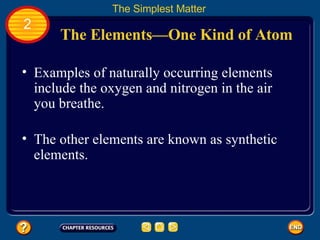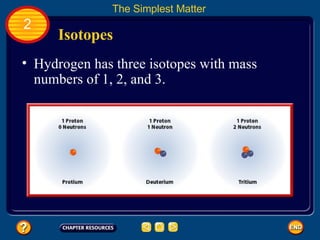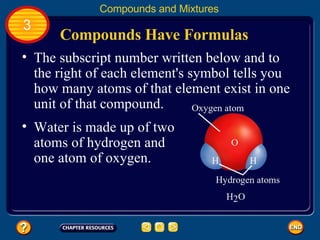Ch 11: 2&3 Elements, Compounds, and Mixtures
- 1. Chapter 11: Atoms, Elements, Compounds, and Mixtures Table of Contents Section 3: Compounds and Mixtures Section 1: Models of the Atom Section 2: The Simplest Matter
- 2. Begin Section 2 The Elements—One Kind of Atom An element is matter made of only one kind of atom. At least 115 elements are known and about 90 of them occur naturally on Earth. The Simplest Matter 2
- 3. The Elements—One Kind of Atom Examples of naturally occurring elements include the oxygen and nitrogen in the air you breathe. The other elements are known as synthetic elements. The Simplest Matter 2
- 4. The Periodic Table— Charting the Elements Chemists have created a chart called the periodic table of the elements to help them organize and display the elements. Each element is represented by a chemical symbol that contains one to three letters. The Simplest Matter 2
- 5. The Periodic Table The Simplest Matter 2
- 6. The Periodic Table— Charting the Elements The elements are organized on the periodic table by their properties. The rows in the table are called periods. The elements in a row have the same number of energy levels. The Simplest Matter 2 The columns are called groups. The elements in each group have similar properties related to their structure.
- 7. Identifying Characteristics Each element is different and has unique properties. These differences can be described in part by looking at the relationships between the atomic particles in each element. The Simplest Matter 2
- 8. Number of Protons and Neutrons The top number is the element's atomic number . The Simplest Matter 2 Every atom of chlorine, for example, has 17 protons in its nucleus. It tells you the number of protons in the nucleus of each atom of that element.
- 9. Isotopes The number of protons changes from element to element, every atom of the same element has the same number of protons. However, the number of neutrons can vary even for one element. The Simplest Matter 2 Isotopes (I suh tohps) are atoms of the same element that have different numbers of neutrons.
- 10. Isotopes You can tell someone exactly which isotope you are referring to by using its mass number. An atom's mass number is the number of protons plus the number of neutrons it contains. The Simplest Matter 2
- 11. Isotopes Hydrogen has three isotopes with mass numbers of 1, 2, and 3. The Simplest Matter 2
- 12. Atomic Mass The atomic mass is the weighted average mass of the isotopes of an element. The Simplest Matter 2 The atomic mass is the number found below the element symbol. The unit that scientists use for atomic mass is called the atomic mass unit, which is given the symbol u. It is defined as 1/12 the mass of a carbon-12 atom.
- 13. Classification of Elements Elements fall into three general categories—metals, metalloids (ME thu loydz), and nonmetals. The Simplest Matter 2 Metals generally have a shiny or metallic luster and are good conductors of heat and electricity. All metals, except mercury, are solids at room temperature.
- 14. Classification of Elements The Simplest Matter 2 Metals are malleable which means they can be bent and pounded into various shapes. Metals are also ductile, which means they can be drawn into wires without breaking.
- 15. Other Elements Nonmetals are elements that are usually dull in appearance. The Simplest Matter 2 Most are poor conductors of heat and electricity. The nonmetals are essential to the chemicals of life.
- 16. Other Elements Metalloids are elements that have characteristics of metals and nonmetals. The Simplest Matter 2 All metalloids are solids at room temperature. Some metalloids are shiny and many are conductors.
- 17. 2 Section Check Question 1 An element is matter made of only _______ kind of atom. A. one B. two C. three D. four NC: 4.03
- 18. 2 Section Check Answer The answer is A. Aluminum is an example of an element. NC: 4.03
- 19. 2 Section Check Question 2 Chemists organize all the known elements on a particular chart known as the _______. It is called the periodic table of the elements. Not only does the periodic table organize the known elements, it helps predict properties of those that have yet to be discovered. Answer NC: 4.03
- 20. 2 Section Check Question 3 Chlorine-35 has 18 neutrons in its nucleus, while chlorine-37 has 20. How can these both be chlorine atoms? NC: 4.03
- 21. 2 Section Check Answer Chlorine-35 and chlorine-37 are isotopes. Atoms of the same element can have different numbers of neutrons, as long as they have the same number of protons. NC: 4.03
- 22. Begin Section 3 Substances Matter that has the same composition and properties throughout is called a substance . When different elements combine, other substances are formed. Compounds and Mixtures 3
- 23. Compounds A compound is a substance whose smallest unit is made up of atoms of more than one element bonded together. Compounds often have properties that are different from the elements that make them up. Compounds and Mixtures 3
- 24. Compounds Have Formulas H 2 0 is the chemical formula for water, and H 2 O 2 is the formula for hydrogen peroxide. Compounds and Mixtures 3 The formula tells you which elements make up a compound as well as how many atoms of each element are present.
- 25. Compounds Have Formulas The subscript number written below and to the right of each element's symbol tells you how many atoms of that element exist in one unit of that compound. Water is made up of two atoms of hydrogen and one atom of oxygen. Compounds and Mixtures 3
- 26. Compounds Have Formulas No subscript is used when only one atom of an element is present. A given compound always is made of the same elements in the same proportion. Compounds and Mixtures 3
- 27. Mixtures When two or more substances (elements or compounds) come together but don't combine to make a new substance, a mixture results. Unlike compounds, the proportions of the substances in a mixture can be changed without changing the identity of the mixture. Compounds and Mixtures 3
- 28. Mixtures Your blood is a mixture made up of elements and compounds. It contains white blood cells, red blood cells, water, and a number of dissolved substances. Compounds and Mixtures 3
- 29. Separating Mixtures Sometimes you can use a liquid to separate a mixture of solids. At other times, separating a mixture of solids of different sizes might be as easy as pouring them through successively smaller sieves or filters. Compounds and Mixtures 3
- 30. Homogeneous or Heterogeneous Homogeneous means "the same throughout." You can't see the different parts in this type of mixture. Homogeneous mixtures can be solids, liquids, or gases. Compounds and Mixtures 3
- 31. Homogeneous or Heterogeneous A heterogeneous mixture has larger parts that are different from each other. You can see the different parts of a heterogeneous mixture, such as sand water. Compounds and Mixtures 3
- 32. Section Check 3 Question 1 A substance whose smallest unit is made up of atoms of more than one element bonded together is a _______. A. compound B. element C. isotope D. mixture NC: 4.02
- 33. Section Check 3 Answer The correct answer is A. An everyday example of a compound Is H 2 O – water. NC: 4.02
- 34. Section Check 3 Question 2 H 2 0 2 is the _______for hydrogen peroxide. It is the chemical formula. Even a small difference in chemical formulas can result in very different substances. Answer NC: 4.02
- 35. Section Check 3 Question 3 Two or more substances that come together without making a new substance form _______. A. allotrope B. element C. mixture D. solution NC: 4.02
- 36. Section Check 3 Answer The answer is C. You can change the proportions of the substances in a mixture without changing the identity of the mixture itself. NC: 4.02



































